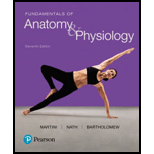
Pearson eText Fundamentals of Anatomy & Physiology -- Instant Access (Pearson+)
11th Edition
ISBN: 9780136874089
Author: Frederic Martini, Judi Nath
Publisher: PEARSON+
expand_more
expand_more
format_list_bulleted
Concept explainers
Question
Chapter 19, Problem 4RQ
Summary Introduction
Introduction:
Plasma is pale liquid component of the blood that consists of proteins, clotting factors and nutrients. Plasma provides the fluidity to the blood.
Expert Solution & Answer
Want to see the full answer?
Check out a sample textbook solution
Students have asked these similar questions
Why cells go through various types of cell division and how eukaryotic cells control cell growth through the cell cycle control system?
please make the drawing and steps of whats it asking.
thank you!
please fill in empty spots.
thank you!
Chapter 19 Solutions
Pearson eText Fundamentals of Anatomy & Physiology -- Instant Access (Pearson+)
Ch. 19 - List five major functions of blood.Ch. 19 - Identify the three types of formed elements in...Ch. 19 - Prob. 3CPCh. 19 - What would be the effects of a decrease in the...Ch. 19 - Prob. 5CPCh. 19 - Prob. 6CPCh. 19 - Prob. 7CPCh. 19 - How would liver disease affect the level of...Ch. 19 - Prob. 9CPCh. 19 - Prob. 10CP
Ch. 19 - Prob. 11CPCh. 19 - Prob. 12CPCh. 19 - Prob. 13CPCh. 19 - Prob. 14CPCh. 19 - Prob. 15CPCh. 19 - Prob. 16CPCh. 19 - List the three primary functions of platelets.Ch. 19 - Prob. 18CPCh. 19 - Prob. 19CPCh. 19 - Prob. 20CPCh. 19 - Prob. 1RQCh. 19 - The formed elements of the blood include (a)...Ch. 19 - Prob. 3RQCh. 19 - Prob. 4RQCh. 19 - Prob. 5RQCh. 19 - Prob. 6RQCh. 19 - Prob. 7RQCh. 19 - Stem cells responsible for lymphocytopoiesis are...Ch. 19 - ______ and _______ affect almost every aspect of...Ch. 19 - Prob. 10RQCh. 19 - Prob. 11RQCh. 19 - Prob. 12RQCh. 19 - Prob. 13RQCh. 19 - Prob. 14RQCh. 19 - Prob. 15RQCh. 19 - Prob. 16RQCh. 19 - Prob. 17RQCh. 19 - Prob. 18RQCh. 19 - Prob. 19RQCh. 19 - Prob. 20RQCh. 19 - Prob. 21RQCh. 19 - Prob. 22RQCh. 19 - Prob. 23RQCh. 19 - Prob. 24RQCh. 19 - Prob. 25RQCh. 19 - Relate the structure of hemoglobin to its...Ch. 19 - Prob. 27RQCh. 19 - Prob. 28RQCh. 19 - Prob. 29RQCh. 19 - Prob. 30RQCh. 19 - Prob. 31RQCh. 19 - Prob. 1CCCh. 19 - Prob. 2CC
Knowledge Booster
Learn more about
Need a deep-dive on the concept behind this application? Look no further. Learn more about this topic, biology and related others by exploring similar questions and additional content below.Similar questions
- please fill in the empty sports, thank you!arrow_forwardIn one paragraph show how atoms and they're structure are related to the structure of dna and proteins. Talk about what atoms are. what they're made of, why chemical bonding is important to DNA?arrow_forwardWhat are the structure and properties of atoms and chemical bonds (especially how they relate to DNA and proteins).arrow_forward
- The Sentinel Cell: Nature’s Answer to Cancer?arrow_forwardMolecular Biology Question You are working to characterize a novel protein in mice. Analysis shows that high levels of the primary transcript that codes for this protein are found in tissue from the brain, muscle, liver, and pancreas. However, an antibody that recognizes the C-terminal portion of the protein indicates that the protein is present in brain, muscle, and liver, but not in the pancreas. What is the most likely explanation for this result?arrow_forwardMolecular Biology Explain/discuss how “slow stop” and “quick/fast stop” mutants wereused to identify different protein involved in DNA replication in E. coli.arrow_forward
- Molecular Biology Question A gene that codes for a protein was removed from a eukaryotic cell and inserted into a prokaryotic cell. Although the gene was successfully transcribed and translated, it produced a different protein than it produced in the eukaryotic cell. What is the most likely explanation?arrow_forwardMolecular Biology LIST three characteristics of origins of replicationarrow_forwardMolecular Biology Question Please help. Thank you For E coli DNA polymerase III, give the structure and function of the b-clamp sub-complex. Describe how the structure of this sub-complex is important for it’s function.arrow_forward
- Molecular Biology LIST three characteristics of DNA Polymerasesarrow_forwardMolecular Biology RNA polymerase core enzyme structure contains what subunits? To form holo enzyme, sigma factor is added to core. What is the name of the structure formed? Give the detailed structure of sigma factor and the function of eachdomain. Please help. Thank youarrow_forwardMolecular Biology You have a single bacterial cell whose DNA is labelled with radioactiveC14. After 5 rounds of cell division, how may cells will contain radioactive DNA? Please help. Thank youarrow_forward
arrow_back_ios
SEE MORE QUESTIONS
arrow_forward_ios
Recommended textbooks for you
 Human Biology (MindTap Course List)BiologyISBN:9781305112100Author:Cecie Starr, Beverly McMillanPublisher:Cengage Learning
Human Biology (MindTap Course List)BiologyISBN:9781305112100Author:Cecie Starr, Beverly McMillanPublisher:Cengage Learning Human Physiology: From Cells to Systems (MindTap ...BiologyISBN:9781285866932Author:Lauralee SherwoodPublisher:Cengage Learning
Human Physiology: From Cells to Systems (MindTap ...BiologyISBN:9781285866932Author:Lauralee SherwoodPublisher:Cengage Learning

Human Biology (MindTap Course List)
Biology
ISBN:9781305112100
Author:Cecie Starr, Beverly McMillan
Publisher:Cengage Learning





Human Physiology: From Cells to Systems (MindTap ...
Biology
ISBN:9781285866932
Author:Lauralee Sherwood
Publisher:Cengage Learning
The Cell Membrane; Author: The Organic Chemistry Tutor;https://www.youtube.com/watch?v=AsffT7XIXbA;License: Standard youtube license